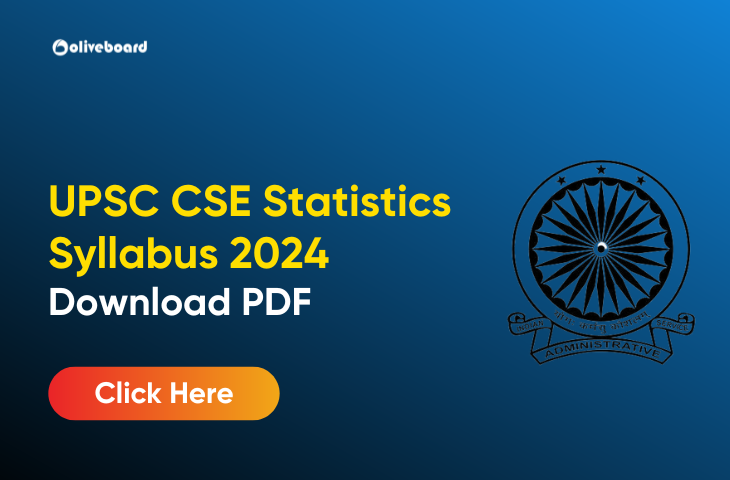UPSC Statistics Syllabus 2024
UPSC Statistics Syllabus 2024 covers key topics like probability, sampling techniques, hypothesis testing, time series analysis, quality control, and design of experiments. Other topics are stochastic processes, linear programming, queuing theory, and statistical applications. The UPSC Statistics Syllabus 2024 aims to develop skills in data analysis, modeling, interpretation, and decision making under uncertainty. The syllabus helps aspirants make data-driven policy decisions in governance.
You can download the UPSC CSE Statistics Optional paper Syllabus from the direct link given below.
UPSC Statistics Syllabus 2024 Overview
There is a list of optional subjects for mains in which there are 48 subjects, from which candidates can choose according to their choice. Statistics is one of the optional subjects for the Civil Services Exam conducted by UPSC. The optional paper is conducted for 250 marks. The UPSC CSE optional subject Statistics Syllabus 2024 has two papers, Paper 1 and Paper 2.
Optional Statistics Syllabus for UPSC CSE 2024
The UPSC Statistics syllabus requires deep conceptual understanding and application skills. It covers probability, inference, sampling theory, quantitative economics, and many subtopics. The wide range makes questions less predictable. Thorough preparation across all areas is essential to master this optional subject.
If you opt for Statistics optional in UPSC mains, prepare it thoroughly. Go through the UPSC CSE Syllabus and previous years’ Statistics papers. Also study relevant Statistics books for UPSC preparation.
UPSC CSE Statistics Syllabus 2024 for Paper 1
1. Probability:
- Sample space and events, probability measure and probability space.
- Random variable as a measurable function.
- Distribution function of a random variable.
- Discrete and continuous-type random variables.
- Probability mass function, probability density function.
- Vector-valued random variable.
- Marginal and conditional distributions.
- Stochastic independence of events and of random variables.
- Expectation and moments of a random variable.
- Conditional expectation.
- Convergence of a sequence of random variables in distribution, in probability, in path mean, and almost everywhere.
- Chebyshev’s inequality, Khintchine’s weak law of large numbers, strong law of large numbers, and Kolmogoroff’s theorems.
- Probability generating function, moment generating function, characteristic function.
- Inversion theorem.
- Linderberg and Levy forms of central limit theorem.
- Standard discrete and continuous probability distributions.
2. Statistical Inference:
- Consistency, unbiasedness, efficiency, sufficiency, completeness, ancillary statistics.
- Factorization theorem, exponential family of distribution and its properties.
- Uniformly minimum variance unbiased (UMVU) estimation.
- Rao-Blackwell and Lehmann-Scheffe theorems.
- Cramer-Rao inequality for single Parameter.
- Estimation methods: moments, maximum likelihood, least squares, minimum chi-square, modified minimum chi-square.
- Properties of estimators, asymptotic efficiency.
- Prior and posterior distributions, loss function, risk function, minimax estimator.
- Bayes estimators.
- Non-randomised and randomised tests, critical function, MP tests, Neyman-Pearson lemma, UMP tests.
- Monotone likelihood ratio, similar and unbiased tests, UMPU tests for single parameter likelihood ratio test.
- Confidence bounds and its relation with tests.
- Kolmogorov’s test for goodness of fit, sign test, Wilcoxon signed-ranks test, Kolmogorov-Smirnov two sample test, run test, Wilcoxon-Mann-Whitney test, median test.
- Wald’s SPRT, Oc and ASN functions, Wald’s fundamental identity.
3. Linear Inference and Multivariate Analysis:
- Linear statistical models.
- Theory of least squares and analysis of variance.
- Gauss-Markoff theory, normal equations.
- Least squares estimates and their precision.
- Test of significance and interval estimates based on least squares theory.
- Regression analysis: linear, curvilinear, orthogonal polynomials.
- Multiple regression, multiple and partial correlations.
- Estimation of variance and covariance components.
- Multivariate normal distribution, Mahalanobis’s D2 and Hotelling’s T2 statistics.
- Discriminant analysis, canonical correlations.
- Principal component analysis.
4. Sampling Theory and Design of Experiments:
- Fixed-population and super-population approaches.
- Probability sampling designs: simple random sampling, stratified random sampling, systematic sampling, cluster sampling.
- Two-stage and multi-stage sampling.
- Ratio and regression methods of estimation.
- Two-phase sampling.
- Probability proportional to size sampling.
- Hansen-Hurwitz and Horvitz-Thompson estimators.
- Non-negative variance estimation.
- Fixed effects model, random and mixed effects models.
- Completely randomized design, randomized block design, Latin square design.
- Incomplete block designs, balanced incomplete block design.
- Factorial experiments, confounding, split-plot design, simple lattice designs.
- Duncan’s multiple range test.
UPSC CSE Statistics Syllabus 2024 for Paper 2
1. Industrial Statistics:
- Process and product control.
- General theory of control charts.
- Different types of control charts for variables and attributes: X, R, s, p, np charts, cumulative sum chart.
- Single, double, multiple, and sequential sampling plans for attributes.
- OC, ASN, AOQ, and ATI curves.
- Concepts of producer’s and consumer’s risks, AQL, LTPD, and AOQL.
- Sampling plans for variables, use of Dodge-Romin tables.
- Concept of reliability, failure rate, and reliability functions.
- Reliability of series and parallel systems.
- Renewal density and renewal function.
- Failure models: exponential, Weibull, normal, lognormal.
- Problems in life testing, censored and truncated experiments for exponential models.
2. Optimization Techniques:
- Models in Operations Research, their construction and general methods of solution.
- Simulation and Monte Carlo methods.
- Formulation of Linear Programming (LP) problem, simple LP model and its graphical solution.
- Simplex procedure, two-phase method, M-technique with artificial variables.
- Duality theory of LP and its economic interpretation.
- Sensitivity analysis.
- Transportation and assignment problems.
- Rectangular games, two-person zero-sum games.
- Replacement policies: group and individual.
- Scientific inventory management, analytical structure of inventory problems.
- Storage models with deterministic and stochastic demand with and without lead time.
- Homogeneous discrete-time Markov chains, transition probability matrix.
- Homogeneous continuous-time Markov chains, Poisson process.
- Elements of queuing theory: M/MI, M/M/K, G/M/l and M/G/1 queues.
- Solution of statistical problems using statistical software packages like SPSS.
3. Quantitative Economics and Official Statistics:
- Determination of trend, seasonal, and cyclical components.
- Box-Jenkins method, tests for stationary series, ARIMA models.
- Commonly used index numbers: Laspeyre’s, Paasche’s, Fisher’s ideal index numbers.
- Chain-base index number.
- General linear model, ordinary least square, and generalized least squares methods of estimation.
- Problem of multicollinearity, autocorrelation, heteroscedasticity of disturbances.
- Test for independence of disturbances, concept of structure and model for simultaneous equations.
- Present official statistical system in India relating to population, agriculture, industrial production, trade, and prices.
4. Demography and Psychometry:
- Demographic data from census, registration, NSS, other surveys.
- Vital rates and ratios, measures of fertility, reproduction rates, morbidity rate.
- Standardized death rate, complete and abridged life tables.
- Logistic and other population growth curves, population projection, stable population, quasi-stable population.
- Techniques in estimation of demographic parameters.
- Standardization of scales and tests, Z-scores, standard scores, T-scores, percentile scores.
- Intelligence quotient and its measurement and uses.
- Validity and reliability of test scores, factor analysis, path analysis in psychometry.
UPSC tests conceptual knowledge of statistics and the ability to apply analytical tools to derive insights from data. Mastering the UPSC Statistics Syllabus 2024 develops critical thinking abilities for the exam and public service. The dynamic syllabus makes statistics relevant for understanding real-world issues in modern India.
| Important Links | Important Links |
| UPSC CSE 2024 Apply Online | UPSC CSE 2024 Notification |
| UPSC CSE Eligibility Criteria | UPSC CSE Syllabus |
| UPSC CSE Exam Pattern | UPSC CSE Selection Process |
UPSC Statistics Syllabus 2024 FAQs
UPSC Statistics Syllabus 2024 covers key topics like probability, sampling techniques, hypothesis testing, time series analysis, quality control, and design of experiments. Other topics are stochastic processes, linear programming, queuing theory, and statistical applications. The UPSC Statistics Syllabus 2024 aims to develop skills in data analysis, modeling, interpretation, and decision making under uncertainty. The syllabus helps aspirants make data-driven policy decisions in governance.
Get Syllabus PDF here: UPSC CSE Statistics Syllabus
There is 250 marks is for one optional paper.

Hello, I’m Aditi the creative mind behind the words at Oliveboard. As a content writer specializing in state-level exams, my mission is to simplify complex exam information and help aspirants navigate their journey with clarity and confidence.
Having walked the path of an aspirant myself, I bring a unique, relatable perspective to my work. I focus on crafting accessible and accurate content on Exam Notifications, Admit Cards, and Results, ensuring candidates have the right information at the right time.
At Oliveboard, I play a key role in empowering students by breaking down the exam process into understandable and actionable insights. My aim is to make preparation less daunting and more rewarding, one well-informed step at a time.
